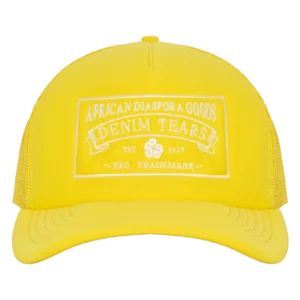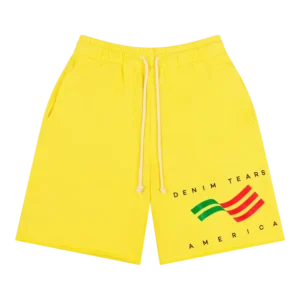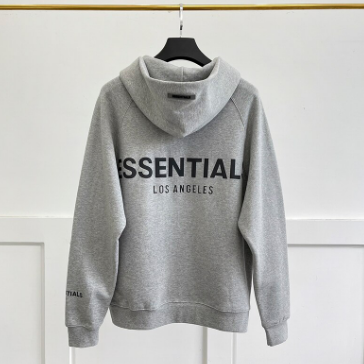In the global landscape of fashion, few garments appear as simple—or as universal—as shorts. They are the stripped-down sibling of pants, designed for comfort, movement, and leisure. Yet in the hands of Tremaine Emory and his brand Denim Tears,Shorts something as unassuming as shorts is transformed into a canvas for history, protest, and pride.
The Denim Tears Shorts embody the label’s larger philosophy: that clothes must tell stories. They are not just seasonal pieces for warm weather, but powerful cultural artifacts—bearing the motifs of cotton wreaths, Pan-African colors, and historical symbolism that tie directly to the African diaspora’s struggles and triumphs. Much like the Denim Tears Sweatpants or Jeans, the shorts carry the weight of Emory’s vision: reclaiming symbols of oppression and reframing them as emblems of resilience and cultural pride.
In this essay, we’ll explore how the Denim Tears Shorts became iconic, tracing their design language, cultural meaning, and resonance across communities.
1. The Cultural History of Shorts
To appreciate why Denim Tears Shorts matter, one must first understand the garment’s cultural evolution.
-
Practical Beginnings
Shorts were historically worn by young boys in Europe as school uniforms, considered inappropriate for adult men until the mid-20th century. They symbolized youth, activity, and leisure. -
Sports & Workwear
In the early 20th century, shorts were adopted by athletes for track and field, boxing, and later basketball. They were designed for performance and ventilation, representing functionality over fashion. -
Counterculture & Streetwear
By the 1980s and 90s, shorts became an everyday staple in skateboarding, hip-hop, and casual culture. Baggy silhouettes in denim or cotton became symbols of rebellion, nonchalance, and authenticity. -
Luxury Elevation
In the 21st century, shorts were redefined by luxury brands, worn on runways and styled with tailored pieces. They no longer symbolized only leisure—they carried prestige.
It is in this final chapter that Denim Tears Shorts enter: not just as garments of comfort, but as vessels of storytelling, reclamation, and cultural power.
2. Tremaine Emory’s Philosophy in Shorts
Tremaine Emory’s brand, Denim Tears, operates with a distinct philosophy: fashion is history made wearable.
Emory uses his shorts as part of a larger narrative that addresses the African American experience, colonial histories, and diasporic pride. By placing motifs such as cotton wreaths on shorts, Emory brings forgotten stories into everyday life.
Why shorts? Because they are universal. Unlike denim jeans, which carry associations with Americana, or sweatpants, tied to athletic leisure, shorts are neutral ground. They are unpretentious, accessible, and direct, making them a powerful medium for communicating weighty cultural ideas.
3. The Design Language of Denim Tears Shorts
What makes these shorts iconic lies in their design elements, which blend comfort with symbolism.
-
The Cotton Wreath Motif
One of the most defining features of Denim Tears Shorts is the all-over cotton wreath print. This design references cotton—the crop enslaved Africans were forced to pick for centuries under brutal conditions. Instead of erasing the symbol, Emory reclaims it. Cotton becomes a marker of survival and pride, stitched into everyday garments like shorts. -
Pan-African Colorways
Some versions of the shorts utilize red, green, and black, the colors of the Pan-African flag. Red symbolizes the blood shed, green represents the land, and black stands for the people. This transforms the shorts into a mobile flag of solidarity. -
Typography & Slogans
Select editions of Denim Tears Shorts feature protest text or historical references. These transform the shorts into wearable manifestos, carrying political weight in a casual garment. -
Material & Fit
Made in heavyweight cotton fleece, denim, or twill, the shorts balance durability and comfort. Their silhouettes are relaxed—often oversized and boxy—mirroring the shapes popular in streetwear. -
Details
Elastic waistbands, drawstrings, and functional pockets ensure utility while letting the design language dominate. Denim Tears never strips the shorts of practicality—the symbolism is layered onto a garment meant to be lived in.
By fusing history with function, Denim Tears Shorts epitomize Emory’s belief that fashion can be both comfortable and radical.
4. Shorts in Collaboration
Denim Tears Shirts have gained additional cultural weight through collaborations.
-
Denim Tears x Levi’s
While jeans were the centerpiece of this partnership, shorts carried the same cotton wreath motif, expanding the denim story into warmer-weather silhouettes. -
Denim Tears x Converse
Styled alongside iconic sneakers, the shorts complete a cultural “uniform” that ties athletic roots with historical storytelling. -
Denim Tears x Dior
By working with Dior, Emory elevated shorts into luxury spaces, showing that even casual silhouettes can carry monumental symbolism when paired with couture craftsmanship.
Through collaborations, Denim Tears Shorts transcend their role as seasonal basics—they become conversation pieces recognized globally.
5. Why Denim Tears Shorts Resonate
Several factors explain the cultural resonance of these shorts:
-
Universality
Shorts are worn across ages, genders, and geographies. This makes them a powerful medium for reaching wide audiences. -
Summer Staple with Depth
Traditionally, shorts are seen as carefree summer wear. Denim Tears flips this expectation, embedding heavy symbolism into garments of lightness. -
Conversation Starters
The cotton wreath motif invites curiosity. When someone asks, “What does that design mean?”, the shorts begin telling history. -
Celebrity Endorsement
Musicians, athletes, and artists have been seen wearing Denim Tears Shorts, amplifying their visibility and symbolic power. -
Bridging Streetwear and Luxury
Shorts can swing between casual and elevated. Denim Tears leverages this duality, making them equally viable on the streets or in luxury fashion circles.
6. Shorts as Cultural Archive
The Denim Tears Shorts are more than garments; they function as archives. By embedding African American history into casualwear, they preserve memory in a form that cannot be ignored.
Think of them as wearable museum pieces—yet unlike objects locked in glass, they move through cities, parks, and neighborhoods. They democratize history, carrying it out of textbooks and into everyday life.
7. Why They’re Iconic
The Denim Tears Shorts are iconic because they:
-
Reclaim Cotton: Transforming a symbol of forced labor into resilience.
-
Embed Pan-African Pride: Carrying the colors of unity and liberation.
-
Bridge Comfort and Protest: Shorts typically symbolize ease; Denim Tears fuses that with cultural weight.
-
Democratize Storytelling: A universal garment shares specific narratives.
-
Blend Streetwear and Luxury: Standing firmly in both worlds.
-
Function as Archive: Living testimony to history and identity.
8. The Future of Denim Tears Shorts
Looking ahead, Denim Tears Shorts may expand into sustainable fabrics, digital storytelling, or interactive design. Imagine shorts with scannable QR codes linking wearers to historical archives, or eco-conscious cotton that reclaims agriculture in new ways.
But their core essence will not change: shorts that carry truth in comfort.
Conclusion
The Denim Tears Shorts prove that no garment is too small or too simple to carry deep cultural weight. By embedding cotton wreaths, Pan-African colors, and historical narratives into their design, Tremaine Emory transforms shorts into symbols of history, resilience, and pride.
They balance ease with education, leisure with liberation. They spark conversations wherever they go. And in doing so, they remind the world that even a humble pair of shorts can be iconic—when they tell the right story.
To wear Denim Tears Shorts is to honor the past, embody pride in the present, and carry history into the future. They are not just summer staples; they are artifacts of survival, strength, and identity—woven into the very fabric of comfort.







